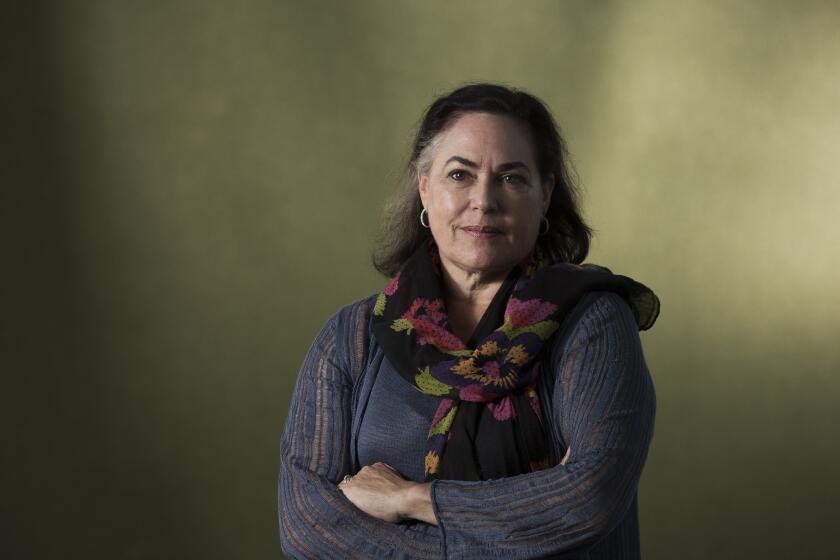In Amy Bloom’s exquisite ‘I’ll Be Right Here,’ Colette plays a key supporting role

- Share via
Book Review
I'll Be Right Here
By Amy Bloom
Random House: 272 pages, $28
If you buy books linked on our site, The Times may earn a commission from Bookshop.org, whose fees support independent bookstores.
Amy Bloom’s exquisite “I’ll Be Right Here” is a slim volume spanning close to a century. While it’s tempting to label the novel a family epic, that description would fail to capture how Bloom reconstitutes “family” on the page, or how her chapters ricochet forward and backward from decade to decade or year to year, shifting perspective not only from character to character, but from first- to third-person point of view.
These transitions, while initially dizzying, coalesce into a rhythm that feels fresh and exciting. Together they suggest that memory conflates the past, present and future, until at the end, our lives can be viewed as a richly textured tapestry of experience and recollection, threaded together by the people we’ve loved.
The novel opens with a tableau: Siblings Alma and Anne tend to their longtime friend, who’s dying. They tenderly hold Gazala’s hands in a room that “smells like roses and orange peel.” Honey — once Anne’s sister-in-law and now her wife — massages Gazala’s thin feet with neroli oil. “Anne pulls up the shade. The day is beautiful. Gazala turns her face away from the light, and Alma pulls the shade back down.” Samir “presses his hand over his mouth so that he will not cry out at the sight of his dying sister.” Later in the novel, these five will come to be dubbed “the Greats” by their grandchildren.
The scene is a foreshadow, and signals that the novel will compress time, dwelling on certain details or events, while allotting mere lines to other pivotal moments, or allowing them to occur offstage, in passing. At first this is disorienting, but Bloom’s bold plot choices challenge and enrich.

In 1930 Paris, a young Gazala and her adopted older brother, Samir, await the return of their father from his job at a local patisserie, when they hope to sample “cinnamon montecaos, seeping oil into the twist of paper,” or perhaps a makroud he’s baked himself. In their cold, tiny apartment, Samir lays Gazala “on top of his legs to warm us both, and then, as the light fails, our father comes home.”
The Benamars are Algerians, “descended from superior Muslims and Christians both, and a rabbi,” their father, M., tells them. He delights in tall tales of a Barbary lion that has escaped Northern Africa and now roams the streets of Paris. Years elapse in the course of a few pages, and it’s 1942 in Nazi-occupied France. One night before bed, M. Benamar shreds the silk lining from a pair of worn gabardine pants to craft a belt for his daughter. Then,“he lies down on the big mattress he shares with Samir and turns his face to the wall.” He never awakens.
Now orphans — we don’t know exactly how old they are — the pair must conceal that they are on their own. Samir lines up a job where their father worked, while the owner’s wife finds Gazala a position as companion to a renowned writer, offering her “up to Mme. Colette like a canape.” Colette (yes, that one!) suffers from arthritis, and is mostly bedridden. She hides her Jewish husband upstairs, while entertaining guests below. Gazala observes that her benefactor’s “eyes are slanted under the folds of her brows, kohl-rimmed cat’s eyes in a dead-white face, powder in every fold and crack.”
Soon, the sister and brother’s paths diverge, and Gazala makes her way to New York City.
“There is no such thing as a good writer and a bad liar,” Amy Bloom wrote in her 1999 short story “The Story,” which remains my favorite of all her work.
It’s 1947. Through Colette, Gazala has found work at a shop on Second Avenue, and sleeps in the storeroom above. Enter Anne and Alma Cohen, teenage sisters who take an instant liking to Gazala and her French accent; in short order, they’ve embraced her as a third sibling. Months later, there is a knock on the bakery door, and it’s Samir, returned from abroad, in search of Gazala. For the rest of their lives, the nonblood-related siblings will conceal that they are lovers.
Going forward, the plot zigs and zags, dipping in and out of each character’s life. It’s 2010 in Poughkeepsie, N.Y., where Samir and Gazala have lived together in a rambling old house for decades, maintaining appearances by keeping separate bedrooms. They are old, and Samir “brushes her silver hair away from his lips.” She tells him she doesn’t mind that he smells of the shallots in their garden.
It’s 1968, and Anne, by now a wife, mother and lawyer, has fallen in love with her husband Richard’s sister, Honey. We glimpse their first sexual encounter after years of simmering emotions. Alma — who receives minimal attention from her author — marries a bighearted chicken farmer named Izzy, and later grieves the early loss of her husband, and the absence of children.
As they grow older, the circle consisting of Gazala, Samir, Anne, Alma and Honey will grow to include Lily, Anne’s daughter, and eventually Lily’s daughter, Harry. Gazala and Samir take in Bea, whose parents were killed in a car accident; she becomes the daughter they never had. This bespoke family will support each of its members through all that is to come.
It’s 2015 in Poughkeepsie, and Gazala’s gauzy figures float through her fading consciousness. Beneath the tree outside her window — ”huge and flaming gold” — sits her father, reading the paper. “Madame pours mint tea into the red glasses.” The other Greats are gathered round. One last memory, the most cherished of all: It’s 1984 and Gazala and Samir are in their 50s. He proposes a vacation in Oaxaca. “Let’s go as we are,” he whispers. At their hotel, “they sit beneath the arches, admiring the yellow sun, the blue sky, the green leaves on the trees, all as bright as a children’s drawing.” There, they freely express their love for each other.
‘Death with dignity’ laws make assisted suicide possible in the U.S., but those laws don’t apply if you’re suffering from Alzheimer’s.
As Bloom has demonstrated throughout her stellar literary career, which began in 1993 with the publication of her acclaimed story collection, “Come to Me,” she can train her eye on any person, place or object and render it sublime. Her prose is so finely wrought it shimmers. Again and again she has returned to love as her primary subject, each time finding new depth and dimension, requiring us to put aside our expectations and go where the pages take us. As readers, we’re in the most adept of hands.
Haber is a writer, editor and publishing strategist. She was director of Oprah’s Book Club and books editor for O, the Oprah Magazine.
More to Read
Sign up for our Book Club newsletter
Get the latest news, events and more from the Los Angeles Times Book Club, and help us get L.A. reading and talking.
You may occasionally receive promotional content from the Los Angeles Times.











